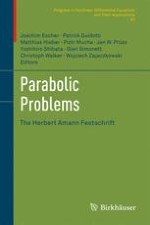2011 | Book
Parabolic Problems
The Herbert Amann Festschrift
Editors: Joachim Escher, Patrick Guidotti, Matthias Hieber, Piotr Mucha, Jan W. Prüss, Yoshihiro Shibata, Gieri Simonett, Christoph Walker, Wojciech Zajaczkowski
Publisher: Springer Basel
Book Series : Progress in Nonlinear Differential Equations and Their Applications
